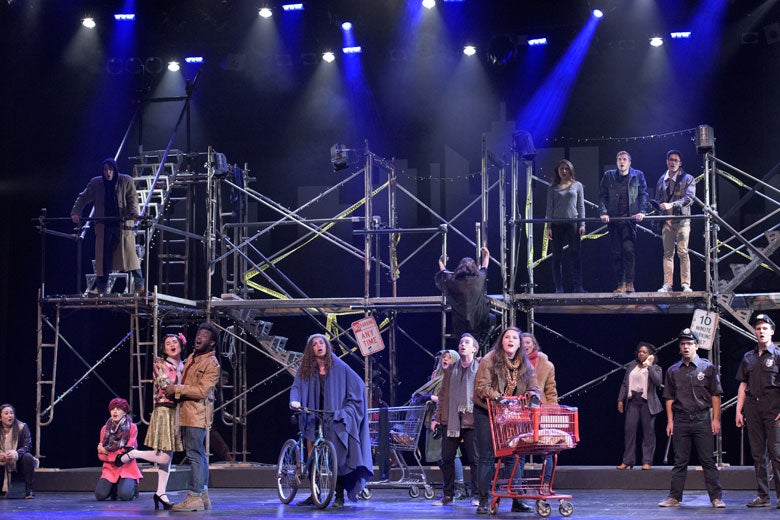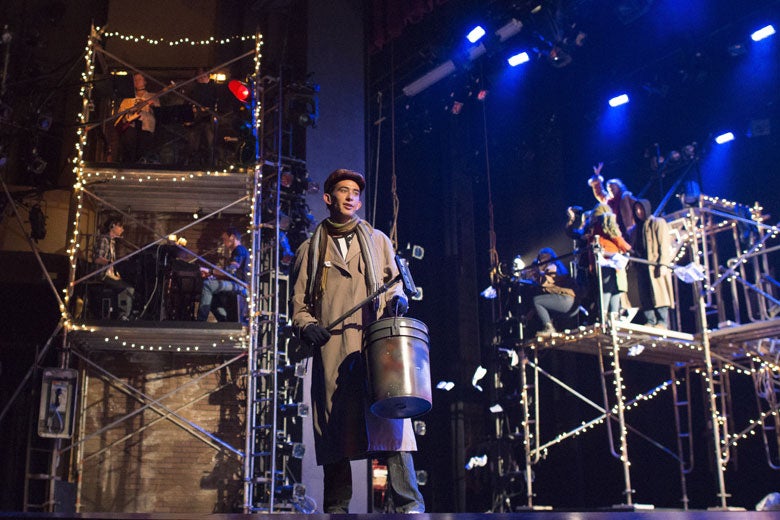When today’s Stanford students were coming into the world, speaking their first words and taking their first steps, Rent was being born on Broadway.
Rent, Jonathan Larson’s 1996 rock musical about struggling artists in New York City, a contemporary haven for alternative lifestyles, captured the zeitgeist of the end of the 20th century in America.
Rent also captured four Tony Awards, six Drama Desk Awards and the Pulitzer Prize for drama, making it a pop culture phenomenon and an instant classic – just like its inspiration, Giacomo Puccini’s popular opera La bohème about artists in 19th-century Paris that debuted 100 years earlier.
Ram’s Head Theatrical Society at Stanford presents five performances of Rent, April 8-9 and 14-16 at 8 p.m. in Memorial Auditorium. Seating is unreserved and advance ticket prices are $10 for Stanford students, $15 for faculty and staff, and $20 for the general public. Tickets are an additional $2 at the door the day of the performance.
The selection of Rent as the spring production is a testament to the continued relevance of complicated romantic relationships, nontraditional lifestyles, artistic drive and deadly illness. These themes struck a chord in 1896 with La bohème, in 1996 with the original Rent and now 20 years later on the Stanford campus.
Then and now
Set in New York City’s East Village, Rent follows a year in the life of a group of poor young artists and musicians who are struggling with relationships, identity and the specter of AIDS. The first performances were at the New York Theatre Workshop, where the main stage seats less than 200.
Ram’s Head Rent producer Emily Ashton wanted to recreate the immediacy of a small theater in grand Memorial Auditorium, which seats 1,700. One way to do that is to push scenes to the very edge of the stage with automated platforms equipped with motors that enable them to be driven across the stage in a linear motion and to rotate.

The stage scaffolding moves and changes orientation to create new spaces that change the look and feel of the scenes. (Image credit: L.A. Cicero)
Ashton said, “As the platforms move throughout the show, the immense Memorial Auditorium stage shrinks before the audience’s eyes to create a close relationship between the characters and the audience.”
In the more intimate scenes, scaffolding moves forward and changes orientation to create new spaces.
James Sherwood, the production manager, said the movement drastically changes the look and feel of the scenes, establishing different intimate locations. He praises the flexibility of the platforms.
“What they allow us to do is to really condense down the vast cavernous space that is Memorial Auditorium into as intimate a space as possible, allowing the actors to play as close to the audience as possible,” Sherwood said.
Ashton acknowledges that there is more than one way to define the characters in Rent, which when it opened in New York showcased a mix of human traits that were rarely portrayed on stage and came to define a generation of musical theater.
“We are emphasizing a range of diversity, including diversity of race, gender, sexual orientation, body type and the intersection of those identities,” she said.
Reflecting on Rent, then and now, she added, “While Rent focuses on some issues specifically relevant to the AIDS epidemic of the 1980s and 1990s, many of the issues portrayed in the musical, such as racial and sexual discrimination, and love and relationships, are more relevant than ever to young people today, specifically with the current state of politics and political activism both on campus and in the country as a whole.”
Heights of bravery
Another way Ram’s Head brings the actors and audience close together is by eliminating the orchestra pit that is often in front of the stage. The five-piece band that provides the live score in Memorial Auditorium is perched on the sides of the stage in the set scaffolding for the duration of the production. Recruiting for this component of the company required the producer and music director to include “must not be afraid of heights” in the audition packet.

Band members providing the live score are perched in the set scaffolding; the audition packet warned “must not be afraid of heights.” (Image credit: L.A. Cicero)
Because the band members are physically separated from each other, each musician wears headphones with a dedicated sound mix crafted just for them, and has a small video feed of the music director. Though often utilized in professional musical theater, these technical components are new to Ram’s Head.
The five-member band includes Rent‘s music director, Makulumy Alexander-Hills, on keyboards. Alexander-Hills, a senior double-majoring in music and Earth systems, is a theater veteran, having been involved with numerous Stanford productions over the last four years. He also has worked with the local professional company TheatreWorks and interned with American Repertory Theater in Cambridge, Massachusetts, in 2014.
Alexander-Hills said, “This production is certainly the most complex show that I have worked on at Stanford, which seems appropriate since it is my last Ram’s Head musical.”
He explained he is using an elaborate keyboard setup that uses a single computer to program three keyboards live during the show.
“Getting the band set up in the scaffolding towers with all the sound cables, headphone mixes and video feeds took us about six hours. By contrast, setting up the entire 21-piece orchestra for Les Misérables, the Ram’s Head spring show in 2014, took just over two hours. It is exciting, though, because this is the way professional musical theater operates,” Alexander-Hills said.
“It has been a great experience for me before moving to New York City this summer to start my career.”
As a last hurrah, the Ram’s Head cast of Rent will reprise their roles on April 24 at TedxStanford: The Human Race, where they will close the conference with the song “Seasons of Love” from the opening of the second act.
Media Contacts
Robin Wander, University Communications: (650) 724-6184, robin.wander@stanford.edu